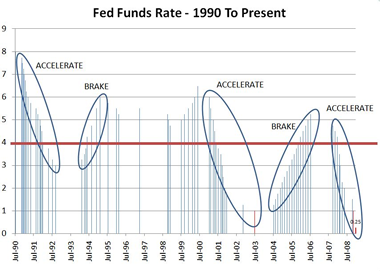Economic Data That Fool Us
SEARCH BLOG: ECONOMY
As I was reading Thursday's The Wall Street Journal, I came across a couple of graphs that just struck me as wrong! The first one showed private industry job losses reported by ADP Employers Services. Although the numbers were missing from the chart, I have recreated it below showing monthly job losses from July 2008 through July 2009. The story it tells is, although the most recent job losses were worse than expect, they were the fewest in 9 months.
But I think the real story is this:
Rather than talking about July's losses of 371,000 jobs, we can see the real picture is that we have lost nearly 6,000,000 private-industry jobs in a year. But wait, this picture is still deceiving. There is a matter of scale. The 700,000 in the top chart looks too much like the 6,000,000 in the bottom chart. So lets try again.
The second chart offered a comparison of the "gap... in billions of dollars... between spending and revenue in the Waxman House bill from 2010-2029" for the Obama health care program. This chart shows annual differences.
Of course, this also is a problem of graphic scaling which makes it difficult to appreciate the information being shown. Therefore, I rescaled the charts to make it a little easier for you. I kept the annual deficit chart [left] to the original scale and stretched out the cumulative deficit chart [right] so that they both used the same scale. Sorry for the miniaturization. Click the image below for a full-sized version. Yup, that's more like it. The $188 billion in 2029 becomes a cumulative underfunding of $1.5 trillion ... that's $1,500 billion... that's $1,500,000,000,000 that has to be made up from some new sources of revenue. And guess where that is. Of course, that is based on a conservative estimate of spending only twice as much as the revenues from the program.
Yup, that's more like it. The $188 billion in 2029 becomes a cumulative underfunding of $1.5 trillion ... that's $1,500 billion... that's $1,500,000,000,000 that has to be made up from some new sources of revenue. And guess where that is. Of course, that is based on a conservative estimate of spending only twice as much as the revenues from the program.
Here are just two examples of how we fail to grasp the significance of data because of the way the data are presented.
Here is another...Global Warming - It's How You Say It
and here Global Warming - A Clearer Perspective
It's not intentional lying; it's just presenting information in a way that hides the truth.
..










